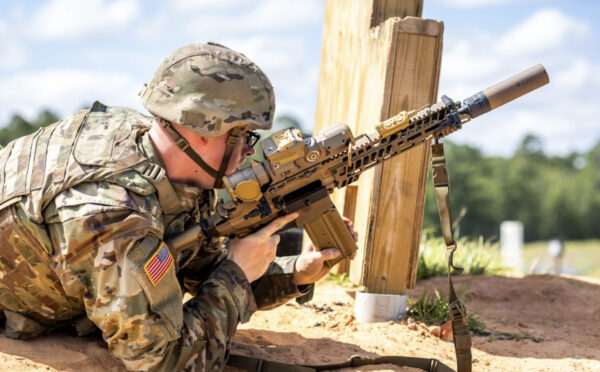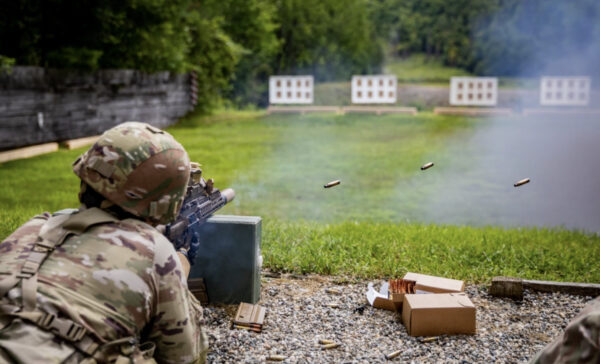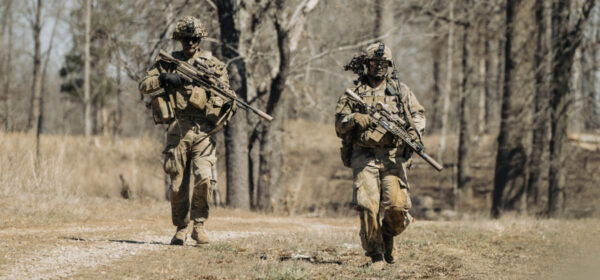The U.S. Army’s adoption of the XM7 rifle chambered in 6.8×51mm is more than just a hardware upgrade—it’s reopened a generational debate about what matters more in a gunfight: a heavier, harder-hitting round, or more rounds on hand when it counts?
With troops now training and deploying with the XM7—the centerpiece of the Next Generation Squad Weapon (NGSW) program—the Army insists the increased lethality of the 6.8mm cartridge justifies the tradeoff in magazine capacity, weight, and overall loadout.
But not everyone agrees. And the arguments echo decades of past military decisions that balanced kinetic power with fire superiority.
From M4A1 to XM7: What’s Changing?
The XM7 is essentially a modernized, piston-driven evolution of the M4 platform. Based on SIG Sauer’s MCX Spear design, it fires a hybrid-cased 6.8×51mm round—known in the civilian world as the .277 SIG Fury—that delivers incredible terminal performance and improved range.
It’s designed to punch through modern body armor, giving U.S. troops an edge against near-peer adversaries like China and Russia.
But that performance comes with a cost.
- XM7 Magazine Capacity: 20 rounds
- XM7 Unloaded Weight: 8.18 lbs (9.84 lbs with suppressor)
- M4A1 Magazine Capacity: 30 rounds
- M4A1 Unloaded Weight: 6.54 lbs
Soldiers carrying seven magazines would go from 210 rounds (M4A1) to just 140 rounds (XM7).
U.S. Soldiers assigned to the 4th Battalion, 118th Infantry Regiment, 218th Maneuver Enhancement Brigade, South Carolina Army National Guard, conduct an Integrated Training Weapons Strategy (ITWS) qualification table for the newly fielded Next Generation Squad Weapon Rifle (NGSW-R) XM7 and Next Generation Squad Weapon Automatic Rifle (NGSW-AR) XM250, during a week-long training event held at Fort Stewart, Georgia, June 20, 2024. (U.S. Army National Guard photo by Spc. Turner Horton)
Carrying more ammunition would mean carrying more weight, in addition to heavier optics, suppressors, and other gear required for 21st-century warfare.
Capt. Braden Trent’s Paper: A Spark in the Powder Keg
Army Capt Braden Trent wrote a detailed critique while studying at the Marine Corps’ Expeditionary Warfare School.
In his field observations of a Fort Campbell live-fire exercise, Trent documented troops nearly running out of ammo within 10 minutes, struggling to maintain suppression with limited magazine capacity.
At 15 minutes into the simulation, soldiers were scavenging spare mags from radio operators and medics.
Trent’s key point: when logistical resupply is uncertain and suppression is critical to maneuver, magazine capacity becomes more than a number—it’s the deciding factor in whether a unit can overcome a fight or get pinned down.
M14 vs. M16, All Over Again
This isn’t the first time the Army’s wrestled with power versus capacity.
In the ’60s, the M14’s 7.62 punch gave way to the lighter, faster-firing M16 chambered in 5.56. Critics warned it lacked stopping power. But in the jungles of Vietnam, lighter rifles and more rounds won out.
The M4, its modern descendant, proved equally effective in the cities and mountains of Iraq and Afghanistan—until troops began facing better-equipped adversaries with longer reach and body armor.
Same debate. Different decade. Can fewer, harder-hitting rounds replace the volume that’s defined by decades of infantry combat?
What the Army Says
Army officials like Brig. Gen. Phil Kinniery argue that the new round will stop an enemy in one hit, reducing the need for multiple shots. “That [6.8mm] round stops the enemy,” he said, “We’re actually bringing something that stops the enemy at one round.”
The Army has conducted extensive threat simulations, including one-to-one and three-to-one threat ratios in both offensive and defensive scenarios. According to spokespersons from the Program Executive Office Soldier, tests showed soldiers could complete engagements with ammo to spare.
SIG Sauer claims the hybrid-cased 6.8×51 is a breakthrough, delivering superior velocity and energy—outperforming even 6.5 Creedmoor in downrange ballistics, with some loads hitting 2,950 fps and producing over 2,700 ft-lbs of energy. Not bad from a 16″ barrel.
U.S. Army Spc. Andruw Nakamura, an infantryman assigned to Charlie Troop, 1st Squadron, 299th Cavalry Regiment, 29th Infantry Brigade Combat Team, Hawaii Army National Guard fires a XM7 rifle during the 2024 Army National Guard Best Warrior Competition at the Army Mountain Warfare School, Jericho, Vermont, Aug. 6, 2024. (U.S. Army National Guard photo by Sgt. Lianne M. Hirano)
But What About Suppressive Fire?
Suppression isn’t just about hitting targets—it’s about controlling the battlefield space. And for that, volume of fire still matters.
Infantry doctrine (ATP 3-21.8) emphasizes the use of suppressive fire as a key element of maneuver warfare. Fewer rounds mean more reloads and less time shooting. In low-resupply environments—exactly the kind of peer conflict the Army is preparing for—ammo conservation and fire discipline become mission-critical.
And it’s not just about bullets. Heavier rifles, larger-caliber ammunition, and the expectation of greater mobility under drone and sensor threats may make the XM7’s weight a liability.
Soldiers assigned to the 1st Battalion 506 Infantry Regiment, 1st Mobile Brigade Combat Team, 101st Airborne Division (Air assault) equip the Next Generation Squad Weapon (NGSW) during a Combined Arms Live-Fire Exercise (CALFEX). (U.S. Army photo by Sgt Jewell Fatula).
As one Army marksmanship instructor put it, “We’re going to have to rethink how we teach soldiers to shoot. Every round needs to count.”
Civilian Takeaway: Is the 6.8×51 Worth It?
For most civilian shooters, the 6.8×51mm round is overkill—literally and financially.
The .277 SIG Fury (the civilian version of the military round) offers serious ballistic performance, but it comes at a steep cost. At over $3 a round, it’s not practical for training, high-volume shooting, or casual plinking. And with 20-round mags, you’ll be reloading more often unless you carry extra weight.
If you’re into long-range hunting or want to run the same gear the Army’s fielding, there’s a niche appeal here. But for defensive use or high-round-count training, 5.56 and .308 still make more sense. They’re cheaper, easier to find, and more than capable for most real-world scenarios.
The XM7 and 6.8×51 may represent the future of military small arms, but for civilians, they are specialized tools, not replacements for proven platforms.
It’s More Than Just a New Rifle
The XM7 isn’t just a new weapon—it’s a shift in how the Army envisions future combat.
Yes, it hits harder. Yes, it reaches farther. But at the end of the day, gear doesn’t fight the battle—people do. And soldiers will still be the ones hauling weight, managing ammo, and making split-second decisions under fire.
This isn’t just a hardware upgrade. It’s a change in doctrine, logistics, and battlefield assumptions. And whether the XM7 proves itself or not, the questions it raises—about firepower, mobility, and trade-offs—aren’t going away anytime soon.
This was an excellent article (for me)
WHAT IS YOUR PREFERENCE? Harder hitting Ammo? or more Capacity?
BUT MY REAL QUESTION IS : IF YOU CAN TOTALLY RE-MAKE A RIFLE WITH A ROUND THAT IS HARDER
HITTING CAN"T YOU MAKE A MAGAZINE THAT HOLDS 30-40 ROUNDS ALSO ?
Makes me go Hmmmmmmmmmmmmmmm? ![]()
WWG1WGA
NCSWIC




